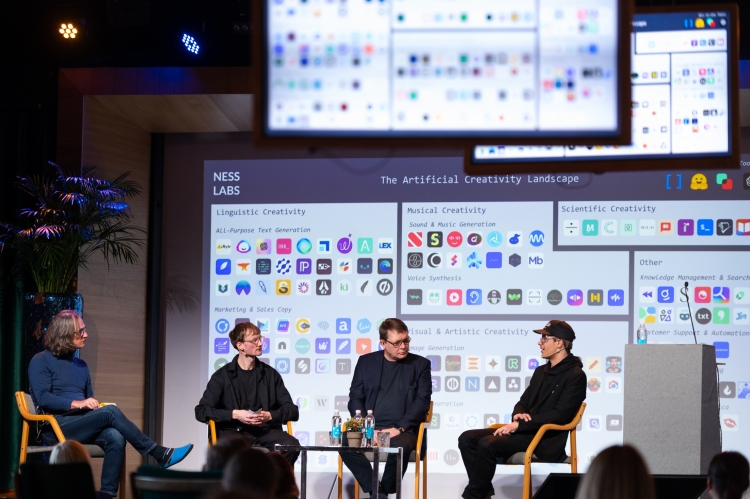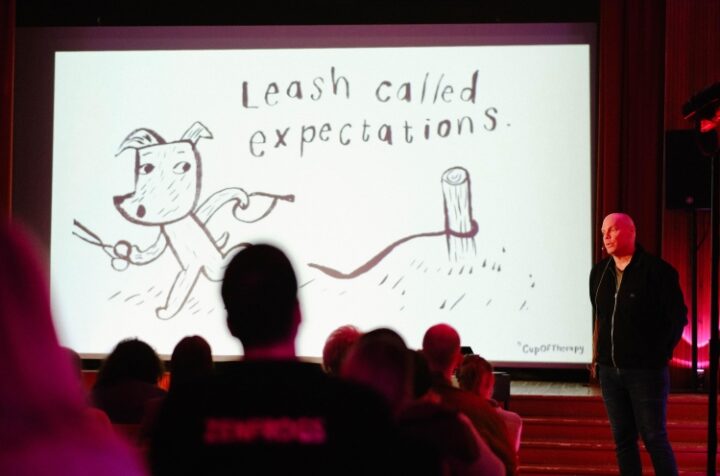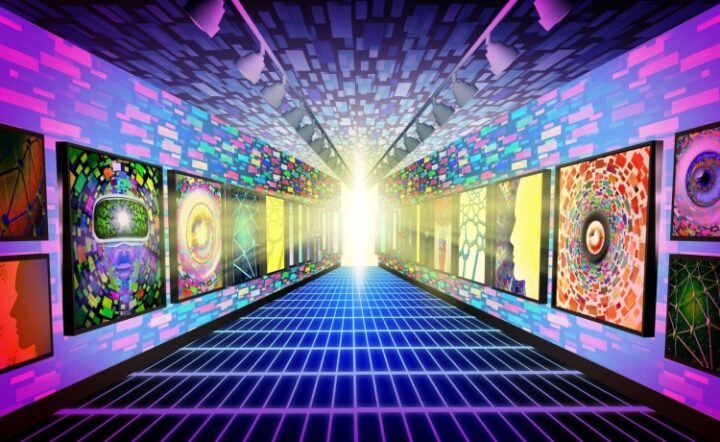What do creatives stand to gain rather than lose from AI shaking up the jobs market?

The digital revolution is here to stay: the rise of artificial intelligence will erase simpler jobs, but at the same time enable everyone to create even greater value and thereby enhance their well-being and prosperity. These thoughts and others were shared at a digital culture forum organised by the Estonian office of the Nordic Council of Ministers (NCM) and Creative Estonia.
“It’s important that we shine the spotlight on the challenges facing the creative economy and cultural organisations as a result of digitalisation,” says Christer Haglund, the director of the Estonian office of the NCM. “It’s also important that we understand what digitalisation means, and ask ourselves whether we truly need to fear that AI could take work away from artists and creatives rather than seeing the innovative and interesting and useful opportunities that it presents.” Seed investor and Change Ventures partner Yrjö Ojasaar adds that we need to predict what the world will be like in seven years’ time and start building solutions that will meet its needs. He gives the example of Veriff, which he says has become a unicorn by doing more or less just that.
Speaking to Geenius, Ojasaar remarks that ongoing transformations in technology are shaking up both the jobs market and society. “Some jobs will disappear, sure, but we know from history that new opportunities will replace them,” he says. His thoughts are echoed by Norwegian media innovator Peder Haugfos. “The rise of Chat GPT and other AIs will allow us to do away with simpler types of work, but producers who make things of true quality will be able to do so even more effectively thanks to AI,” he agrees.
People will not be replaced
Experts agree that although the digital revolution is upon us and that its biggest innovations of late – ChatGPT and similar AIs – are encroaching ever further into people’s lives, they will never fully replace people. Rather, their role will be to provide added value to creative thinking and, with it, more opportunities and increased prosperity.
“In some respects people are definitely irreplaceable,” Ojasaar remarks. “They’re marked out by their creativity, inspiration, ideas and initiative. Computers lack that initiative, that vision, not to mention the capability to actually get things done.” He says computers were created to obey people’s commands and, in so doing, to simplify their work. “They accept and execute our instructions, which makes them reliable assistants,” he adds. “They don’t do the most important things on our behalf, but help us with routine stuff we don’t have the time or inclination to bother with ourselves.”
Estonian theatre manager and producer Peeter Jalakas gives the example of professional photographers, who are no longer needed to take every photo because anyone can do so using their phones. That said, the results tend to be mediocre. “A good photo has to have some thought put into it, about what you’re taking the picture of and why,” he says. “Sure, mobile phones are a useful tool, but not one that’s out there seeking the meaning of life. Someone still has to tell it what to do and how to do it.”
Haugfos gives another example, this time from the media sector. “ChatGPT might replace a journalist in writing an article, but it won’t do any fact-checking,” he says. “The text it comes up with might look perfect, but it could still contain inaccurate information. So if you ask whether journalists will have their jobs taken away from them by robots in the future, the answer’s definitely no.”
The AI itself agrees. We asked the latest i.e. fourth version of ChatGPT whether it would take work from people in the future. “There is no possibility of me taking people’s work from them,” it replied. “My aim is to help people and to enhance human capability in fulfilling a variety of tasks, whether they be in the field of translation, text generation or something else. Yes, I may fulfil certain tasks which have previously been fulfilled by people, but I cannot replace creativity, critical thinking or emotional intelligence, all of which are unique to humans. I wish to work with people, to help them more efficiently achieve their objectives. I do not wish to replace them.”
Digital skills as a hygiene factor
Although AI is not here to do away with people, it will change things on the jobs market. Ojasaar advises everyone to learn to work with technology if they want to remain competitive. “A basic understanding of technology, of how to operate online, will become a hygiene factor,” he says. “That’s the absolute minimum you’ll need to get by on the labour market.”
The reason the requirement for technical awareness is growing due to the rise of AI lies in the fact that the world is getting smaller. “Teams are becoming increasingly international, and they’re having to use technological tools to interact, whether for dividing up work or simply talking to one another,” Ojasaar explains. “People who are capable of using technology find it easier to make contacts and gain access to a lot more clients. Those who learn to work with computers enhance their results, because they’ve got more time to dedicate themselves to the things they’re truly good at.”
https://www.norden.ee/galeriid/digikultuuri-foorum-digital-culture-living-via-avatars-2/
The path to prosperity
Even in the world of art there are examples of AI streamlining people’s work. “Quite a few designers are already using AI to sketch with,” Haugfos reveals, while Jalakas adds that you no longer need to turn to an advertising agency for a catchy slogan, since AI can come up with one for you and eliminate marketing costs.
Jalakas is happy to vouch for the fourth version of ChatGPT, which he describes as a powerful partner he is already able to use to simplify his everyday work. “The rehearsal process in theatres involves sitting down at a table and playing with ideas,” he explains. “You can use AI to really push that. I’ve tested it myself, and it works. The last production I used it on was The Werewolf. AI was there with the rest of us during the rehearsal stage and was of huge help both textually and musically.”
Finnish sculptor and digital artist Erwin Laiho says digitalisation is also making his work easier. He adds that although he won’t be making the switch to 100% digital art at any point, it does allow him to reach new target groups. He sees enormous potential in NFTs. “Unlike other art forms, the visual arts still haven’t found marketing channels or economic models that will enable them to develop online,” he explains. “But in that regard, NFTs undoubtedly represent great opportunities for both.”
As a seed investor, Ojasaar views the development of digital culture as a trend in which it is worth putting your money to grow. “We’re seeing projects that are quite literally changing the world, solving big social problems, and doing so in a scalable way,” he enthuses. “True, those projects are few and far between for the moment. We might have to sift through a thousand of them a year to find a handful worth investing in. But if you want to make money, you have to choose wisely.”
Public support
Advances in this arena are also being supported by the Estonian state via the Ministry of Culture. “We’ve integrated digital culture into our cultural policy,” explains Karlo Funk, an adviser on audiovisual and digital culture at the ministry. “Our aim is for Estonia to pursue a centrally coordinated digital culture policy.”
Funk says that people’s ability to adapt to the rise of AI and to work with it is one of the state’s priorities. This includes developing the hygiene factors mentioned by Ojasaar. “We’ve set ourselves the goal of fostering people’s skills so that they’re capable of making the most of the opportunities that developments in digital culture present,” he explains. “We want the digital competence of people in Estonia to be as high as possible, which is why we support the provision of technical education in universities.”
Also contributing to the development of digital culture in Estonia are the Nordic countries. The digital culture forum was organised by the Estonian office of the NCM, Creative Estonia, the contact points of Creative Europe in the country and the Erasmus+ project Creative Digital Transformation. The idea for the forum came from NCM creative economy and digital adviser Grete Kodi, who has been focussing on the issue over the last 12 months. “My goal is to raise awareness of new digital tools and functions,” she explains. “We want to draw people’s attention to the impact that new technologies, and the business models that come with them, have on creatives and what this major social change means for the management of cultural organisations.”
Stories count
According to Jalakas, four things count when setting up a business in a changing world: to make any sort of breakthrough you need to be able to tell your story, and tell it transparently, gathering as much information and as many mentors around you as you can. “Red lipstick or yellow socks or whatever it might be will help you stick in someone’s mind, and even if someone later copies you, everyone will know you did it first,” he says.
For his part, Haugfos recommends also paying attention to the younger generation and the trends emerging among them. “They’re mostly on TikTok, SnapChat and YouTube, which are competing more and more with the media,” he says. “That means you have to take an increasingly visual approach in order to reach people and get your message across in fewer words.” Jalakas adds that the explosive development of new platforms creates an opportunity for everyone to determine their own fate. “Whereas previously it was difficult to gain access to the media segment, all you need today is a computer,” he says. “It’s easy to make your own media these days, provided you know how to use the technology.”
Ojasaar gives an example from the United Kingdom, where developments in technology are enabling more and more people to become their own bosses. “The global value of the creative economy is a trillion dollars, which is to say a tenth of the world’s GDP,” he explains. “The UK alone accounts for 115 billion of that, and a third of the people working in the creative economy there are self-employed.”
Stories can be told in many ways, including through computer games, which is another rapidly evolving field. Among other things, it is being driven by advances in virtual reality. “VR headsets are good for exercise, too, since they get people moving,” says MaruVR founder Rein Zobel. “Our aim is to create an environment and an experience that feels just like the real world. We want to fill in gaps. Take the pandemic, for example: when people were unable to travel, VR stepped in and replicated it for them.” He adds that developments in VR and the gaming world are leading to increased demand for developers – which chimes with Ojasaar’s notion that although AI may do away with certain jobs, it will create new ones.
The article was produced in cooperation with Estonian news portal www.geenius.ee.
A recording of the ‘Digital Culture – Living via Avatars?’ forum, which took place on 16 March, can be viewed online here:


